[Update: I’ve since been vindicated and my theory about the real location of Gallows Hill has been confirmed – on January 11th, 2016 – by people with a lot more resources, knowledge, and authority than me – though I wrote about it 15 months earlier. See “X Marks The Spot” and “The Gallows Hill Project” for more information.]
______________
[This seemed like a fitting post to start October off with]
I’ll start this post off with a little PSA. This is going to be a lengthy post, primarily because its a subject I’m passionate about but also because it is going to have a lot of pictures. I mean more pictures than have ever been featured in a single post on this blog ever. So you might take that into account depending on what sort of device you are reading this post on. I did consider breaking it up into smaller posts, but I like the narrative flow of it as one large post.
Also, be prepared to learn a few things. With that said..
____________________________________________
Stay Awhile and Listen
I have a story to tell. Its going to be on the lengthy side, so get settled in nicely. After you are done you are going to know a few things I can pretty much guarantee you didn’t know before. Furthermore, you’re going to know a few things that very few people will ever know. The topic is Salem, Massachusetts. SB and I recently traveled to Salem and spent the night there. If you are assuming that the trip was because of the infamous witch trials, then you would not be incorrect. But its a good bit deeper than that. I won’t call myself an expert in many things, but when it comes to the events of 1692, I’d be inclined to wear the title. I’ve done quite a bit of research on the matter, in fact the topic was a portion of my honors thesis. So, being that I am now close to Salem, I had little reason not to go before classes start. SB was more than accommodating, considering that my interest in the topic was a bit (i.e. monumentally) greater than hers. We planned the trip and were off.
Rather than just give you a lecture, I’m going to share few bits of knowledge as I progress through the nutshell version of our trip. I figure this is a better method for a blog anyways. However, I am operating under the assumption that you know the basics of the Salem Witch Trials. By the basics, I do not mean that you have read or watched The Crucible. If you have, and that is your sole understanding of the event, let me get this out of the way:
THIS IS A FICTIONAL MOVIE BASED ON A FICTIONAL PLAY WHICH IS ITSELF AN ALLEGORY ABOUT MCCARTHYISM AND WAS NEVER MEANT TO BE A TREATISE ON THE ACTUAL EVENTS OF 1692.
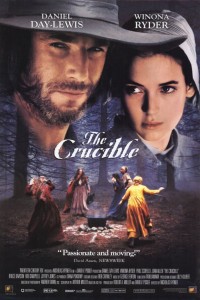 I’m not saying its a bad movie. Its not. Nor am I saying the original play is a bad play, its not. However it is not a good solepoint of knowledge about the Salem trials, because Miller changed a few (many) things for the sake of drama. So if The Crucible is all you know about the Salem trials, at the very least glance over the Wikipedia article and pretend to care before you read the rest of this post.
I’m not saying its a bad movie. Its not. Nor am I saying the original play is a bad play, its not. However it is not a good solepoint of knowledge about the Salem trials, because Miller changed a few (many) things for the sake of drama. So if The Crucible is all you know about the Salem trials, at the very least glance over the Wikipedia article and pretend to care before you read the rest of this post.
Now that that is out of the way, I’m going to share a few points of overview (if you’ve read the Wikipedia entry then most of this won’t be new). First, while we refer to the “Salem witch trials” as if they were part of a singular entity, there were actually multiple towns involved. Salem just formed the epicenter of the action. Furthermore, Salem is better described as the two separate towns which shared the title. The first of which was Salem Towne, which is present day Salem. This was where the harbor was located. The second of which was Salem Village, which is where much of the farmland was. It is further inland (though not landlocked) and is present day Danvers. While these two Salems shared a name, they actually had little in common. In fact, Salem Village had been trying to separate itself from Salem Towne long before it formally became Danvers in 1757 [Side note: Danver’s motto is “The King Unwilling” which stems from the fact that the King (George II) denied their separate charter. But they pretty much said f*ck you and incorporated anyways].
By simply knowing that, you are now far ahead of most people. It should also make a lot more sense as to why I visited both Salem and Danvers, instead of just Salem like most of the fanny-pack brigade. Now you have a basis for the where, lets get started with the trip.
We got up bright and early to make it to a 9:30am ferry. SB and I got to enjoy rush our public transit traffic, which wasn’t too terrible since everybody likes to be a sardine. Our last stop was the “Aquarium” station on the Blue Line, but the train actually went on to a place called “Wonderland” (named after a now non-existent theme park). So I definitely have a favorite T line, riding the train to Wonderland is probably not something most people do.
Once we were harbor side, it didn’t take long for us to find our ferry.
There were also some ducks and a seagull that were waiting for their ride to Salem. Why fly when you can find a boat?
As the ferry pulled away from the harbor we got a nice view of the downtown skyline. Boston is one of those cities where it is very easy to forget just how big of a city you are actually living in. There is also more than one “hub” area, which makes it even easier. It was a nice pleasant view on a nice pleasant day.
As we got further from Boston we entered the myriad of harbor islands. This was a very pretty area and actually has a fair amount of history. The Boston Light is out there as well as the “real” island(s) and partial filming locations on which the movie Shutter Island was based (its a good movie, go watch it). SB and I are planning on visiting at least a couple of these islands this Fall if we have a chance.
During a good chunk of the trip, which took about 50 minutes, we had a Salem native narrating some points of interest for us. He even came around and gave advice on things such as places to eat (more on that in a second). Eventually we came to the mouth of Salem Harbor.
You might not be able to tell it here, but Salem was actually one of the richest cities in the world at one time and in fact was even home to one of United State’s first millionaires. After disembarking from the ferry we began our walk into town. Almost immediately we came across a quirky little home with all sorts of metal sculptures.
It turned out to be a fairly accurate sign of what was to come. Salem has a “heritage trail” that they’ve marked through town via a swath of red paint that you follow. Its pretty much exactly like the “Freedom Trail” in Boston except that its paint. We started following this, which was mostly because it was right along the route I had already planned to get us to our Bed & Breakfast. Said route went along the harbor for a good bit, which took us right by the House of the Seven Gables.
The above is a rather unflattering photo of the house, but we didn’t really have enough interest to pay to go in. Additionally, neither of us had ever even read the book, which kind of diminishes the fun. Beyond that, its not even proven that this house is the House of the Seven Gables. Hawthorne claimed that there was no actual house, but it is very likely that this was the house that gave him inspiration, if nothing else. I’d like to read the book at some point, which would make actually visiting the house more worthwhile.
Further down the harbor we came to a maritime historic site, which we also skipped over because we had lots of more “witchy” things to do. The boat in the picture below is a replica of a 1797 ship named Friendship. The replica bares the same name.
After passing Friendship we started to veer up into town. This took us through the Salem Common which is apparently featured in the Disney Film Hocus Pocus, though I can’t recall if I ever actually saw the movie.
After passing through the commons we got to our B&B and had nice chat with one of the owners. Our room wasn’t ready yet as we were way before check-in, but they held on to our bags for us. By this time both SB and I were hungry so we headed off to get lunch at a place called Red’s. The narrator on the boat had recommended it and so too did the B&B owner, however the owner was nice enough to tell us that Red’s closes after lunch. We were planning on going for dinner, so this was important. As we made our way towards Red’s Salem started to look a little less like a seaport town and a little more like a tourist trap.
Thankfully, most of the town, even the touristy areas, are not especially gaudy. The place is naturally dotted with physics, witches, and warlocks but the historical society keeps things looking pretty reasonable.
Though the spot on our map that the B&B owner circled as Red’s looked pretty far, we got there really quick. The map of the downtown area makes it seem larger than it actually is, which is good when you are walking everywhere (which is easy to do in downtown Salem, a car would have been more trouble than it was worth).
Red’s was very good. I even treated myself to my first Lobster Roll since they were cheaper here than in Boston. Lunch allowed us to kind of chill out for a bit and refuel since we were about to start our itinerary. The first stop was the Salem Witch Museum, we didn’t actually go through the museum yet, we were just stopping to get our combination tickets we ordered online. Our first actual stop was a bit further away, the “Witch House.” Now, this is actually a bit of an odd name for the house. Sure, it has a partial connection to the 1692 trials but there was certainly no witch who lived here. In fact, the house belonged to Judge Jonathan Corwin, one of the presiding judges for the special Court of Oyer and Terminer during the trials. We actually know very little about how Judge Corwin handled himself in the trials. He was a replacement Judge for Judge Nathaniel Saltonstall who resigned after Bridget Bishop was hanged (because he realized the whole thing was a shit-show). Judge Corwin did not resign and ended up being part of a court that saw 20 people die under its watch (not counting those who died in prison). So, while we can’t say he was a proponent of the trials, he certainly wasn’t bothered enough to drop out of the show.
The house itself was very cool. It actually looked creepy from the outside, but that was probably observation bias as much as anything. The inside only partially dealt with the trials. Most of the information was about life at the time and included information on Puritan life in general as well as on specifics such as raising children and superstitions.
They had an ample array of period (and not so period) furnishings, much like most museums of the sort do. While I didn’t learn anything about the trials, I did learn a few things about Puritans in general. Just seeing the house was worth it though, even if it was only moderately connected to the trials. Some people claim trial examinations were held here, but that is actually pretty unlikely, since there would be no reason a Judge would want a trial to be held in his own house (or documents to prove it actually happened).
After seeing the Witch House we walked far, far from the beaten path. In fact we walked so far off the beaten path that the map of Salem was no longer useful. We had transitioned from tourist-land to the parts of town where real people live. The destination was the spot where the accused were hung. Now you might be thinking that that is the kind of place that would surely get a spot on the map. Well.. it did.. sort of. Salem set aside a park of town for a park, named “Gallows Hill Park” (sounds lovely doesn’t it?).
However, its not included in the tourist maps because there isn’t much here aside from a park. Sure, its the spot where official literature would tell you the witches were hung, but its far enough away from the hopping downtown district that no one has made much effort to bring in the fanny-packers. I might bemoan this, if it wasn’t the complete wrong area.
Yes, the official location of where the accused were hung is completely wrong.
But have no fear, not only am I going to tell you where the real spot is, I’m going to show you some pictures of it so you can be totally not amazed and possibly a little sad. But before we do that, we need to have a little fun. Rather than jump straight to the real hanging spot, we’re going to go through the three “fake” spots.
Incorrect Location # 1 – The first thing tourists see at Gallows Hill Park and think “Oh Muh Gherd Dey Hung Here. Quick Billuh Take a Pichur”
To be fair, no actual historian has claimed this spot to be where the accused were hung. Sure a few touristy guides might say this is where is happened because its easy to get to, but you won’t find any (reputable) guide that says this is the spot. However, you can see the appeal of the location can’t you? Its a nice little rock face next to a big field and there are even trees up there. Furthermore, there is a rocky little path right up to the top.
Things get even better, because once you climb up the little hill, there is a big old tree right in the middle of a clearing.
CLEARLY we have found the spot were the witches were hung. Yeah, no. First off, lets establish a few things that we know about the hanging location.
1. The accused were brought to said location in a cart.
2. The accused were hung from trees (locust trees, specifically).
3. Benjamin Nurse rowed a boat from his family’s farm in Salem Village to the base of the hanging hill to retrieve his mother’s body (Rebecca Nurse) by cover of nightfall.
4. There was a crevasse on the hill that the bodies were dumped into.
5. The accused passed over the Town Bridge in their cart before they were hung.
6. Salem was visible from the hill (In other words the hanging spot was right outside town).
Remember. A location must fulfill all these requirements in order to be the real hanging location.
So what is wrong with location number 1? Well, first off, it is indeed a rocky outcropping. There is no way you would get a cart up on top of it easily. Since we know the accused were brought to their point of death in a cart, this means they would have had to walk up onto the outcropping which wouldn’t have had a nice little path. Many of the victims were old and infirm and wouldn’t have been able to be able to walk up onto it even if the cart was not involved, which it was. The spot does have trees, not the right kind, but that doesn’t mean anything given the time in between. However, there is no water near this spot, nor was there in 1692. Additionally, looking around the spot reveals no crevasse. Sure, it could have been filled in over time, but geographically there is no reason for their to have been a crevasse here. Lastly, this spot is in the complete wrong direction from where the Town Bridge (now Bridge Street) would have been, not to mention it is too low to have made Salem visible.
Sorry fanny-packers, but your flawless logic on the hanging spot just does not pan out. Points for picking a cool looking location that is easy to walk to though.
Incorrect Location # 2 – The official location at the top of Gallows Hill in Gallows Hill Park
Next up is the spot that most people, even those well versed in the subject, think is where the witches were hung. Well, obviously they are wrong since I’ve placed it in the incorrect pile. To get to this spot you have to walk up a much larger hill than location 1.
The water tower which was once above, is now quickly becoming level with us. I’ll also note that at this point it was literally about 15-20 degrees hotter than the weather people had told us it was going to be. So SB and I had dressed for much cooler weather and were subsequently melting (oh yes, I just went there). Anyways, by the time we got to the top we were pretty hot, but I was excited to get to the “real” location. This is precisely what I was met with.
So yeah, a flag pole and a basketball court. Seriously. No, I am not kidding, this is the Gallows Hill. It suddenly seems more clear why they don’t put this on the map. But, it does get marginally better (but still wrong). The truth is, they don’t know exactly where they were hung here on the wrong hill. While literature makes it seem like the basketball court area is the official spot, there isn’t much here. If you go up to the edge of the hill (where the witches would have been hung) you are met with this view.
Now, over 300 years ago this brush wouldn’t have been here. So you would have had a nice view of the town (and also gave those below a nice view of the dead hanging people). The thing is, even on this official incorrect hill, they aren’t entirely sure where they were have been hung specifically. So, a little adjacent to the above location is a little marker, complete with a big tree that look like it would have been good to hang people from.
There were even stones left on the marker to memorialize the victims of the hangings. Now, I appreciate the gesture and it isn’t diminished by the fact that this is the wrong spot, but it would be nice if something could exist in the right spot.
So what is the deal? Why is this location the official spot? Additionally, what is wrong with it? Well, this spot can be traced back to historian and Reverend Charles Wentworth Upham, who lived from 1802 to 1875. Upham is known for compiling/writing one of the first major and comprehensive contemporary (at the time, obviously) histories of the Salem events entitled Salem Witchcraft with an account of Salem Village and a history of opinions on Witchcraft and Kindred Subjects, or more commonly just Salem Witchcraft, which was written in 1867. During his research Upham sought to answer a lot of questions, one of which was “Where da fuq is gallows hill?” (yes, just like that).
You see, people like to forget bad things. Especially when these bad things make them look bad. Obviously, the Salem events were a massive embarrassment for most of the people involved. So the townsfolk actually went a far way out of their way to just pretend it never happened. Subsequently, the exact location was never marked and thus historians were left to piece together a myriad of details to pinpoint the spot. Upham was attempting to do this and while he did gather a bit of evidence, he ultimately just guessed. Yes, guessed. In his own words (referring to the spot he chose): “There is no contemporaneous nor immediately subsequent record that the executions took place on the spot.”
You’d think that would have been enough to keep the spot out of the “Concrete Facts Book” that tour guides like to read from. Nope, over time people came to ignore (or forget entirely) that Upham guessed. Though his guess was an educated one, there was too big of a leap to justify labeling his guess as the right spot, fo’ sho, fo’ sho. Not to mention, it didn’t match up with what we know.
First, remember that a cart took them to the hanging location. I can say from first hand experience, that it would be very difficult to get a cart up to this location. I’m not saying it would have been impossible, but I am seriously doubting the Sheriff and his men would have cared enough to go way out of their way to climb some huge hill just to hang people. True, George Corwin (Sheriff) was known for being an asshat, but he had nothing to gain by inconveniencing himself this much. Second, there would have been scarcely any trees up here, let along any strong enough to hang an individual from. Even Upham himself mentions the lack of vegetation, stating about the top of the hill that the “scattered patches of soil are too thin to tempt cultivation.” Third, again, we have no water. While this is marginally closer than the first location, its still over a quarter a mile away from the Crane Brook Benjamin Nurse would have used. Fourth, we have no visible crevasse. This might be explained away by the course of time, but Upham doesn’t mention one in his own period either. You can indeed see Salem from the top of this hill, but that is hardly unique to this hill alone. Finally, we are once again going the wrong way to have crossed over the Town Bridge.
Sorry official literature, this site just does not hold up against what we know.
Incorrect Location # 3 – The secondary hill
The third incorrect location is actually located within Gallows Hill Park as well. This site was actually chosen in response to the errors made on the part of the official site. This created a bit of a knee-jerk reaction among the people who like to “go against the man” and many immediately labeled this the promised land of witch hanging. Well, its not. The origin of this site can be traced to historian/traveller Salvatore Trento, specifically his book Field Guide to the Mysterious Places of Eastern North America. In this book Trento speaks about some of the errors of the Upham site and then goes on to select his own site, located a bit southwest of the official spot. For Trento this site was especially promising because of a few factors.
First, it would have had easy cart access from a street than then ran near it named Colby Street. Second, there was a crevasse near the plateau on top of the hill. Third, Salem was visible from the hill. Forth, there were even footing stones for the gallows! Seems pretty rock solid right?
To find out we trucked back down the big hill, across a field and back into the woods so we could go up to the secondary hill.
This hill wasn’t nearly as tall, but it still provided a nice view of a distant Salem once we got to the clearing.
Things seemed pretty good so far, you could even see the remnants of an old road that Trento mentioned, this would have been very nice for a cart.
And of course, the strongest element of the secondary hill, the footer stones for the gallows.
Some of them even had tool marks still visible.
Now, you have to admit, things are looking pretty good for this site. You even have evidence of the gallows in the rocks. Maybe I was too quick to judge the bandwagon that jumped from Upham’s sight to Trentos.
Nope.
If you have been reading closely, it should already be obvious why this site is wrong. In case you haven’t, lets clear up the final incorrect site.
First, remember, there was water near the hill. This hill is southwest of a hill that was already a quarter of a mile from water. So the secondary hill is nearly one-half a mile from the Crane Brook Benjamin used. Second, the cart path you see is nowhere near Town Bridge, nor is the road to which it would have been connected. Had the accused been brought here, they would have been led across the bridge, then they would have been turned around and led one-half mile away and up another hill, very unlikely. Finally, here is the big one, I hope you caught it. There were no gallows. Remember what we know, the accused were hung from trees. Yes, every single image or video you have ever seen and every word you have ever read about the Salem trials that depicts or mentions a gallows is completely wrong.
Historians have poured over every known record, legal, personal, financial, even religious and have found no mention of gallows being constructed, or found evidence of supplies being ordered to build one. What we do have, are lots of accounts of the victims being hung from locust trees. If there is one thing we do well, its keeping track of our money. Had the gallows existed, its nearly impossible that it would have slipped through every eyewitness, legal, religious, and financial account of the events. So, the core to the Trento site, the footing stones, is completely invalidated.
While at first glance this site seemed promising, its actually worse of a location than the official hill geographically speaking.
So, three locations down. Just where is the real hanging location, do we know? Depending on who you ask, you’ll get different answers to that question. But the answer is yes, yes we do.
The Real Gallows Hill
Now we both know there were no gallows, but gallows hill still serves as a useful name, so we’ll continue to use it.
The actual hanging spot is north of the three prior spots and it is aesthetically going to be a big disappointment for you, trust me.
There it is.
Yes, that is a Walgreens, yes that is a parking lot. And yes, that clump of trees is the hanging hill.
Before you give up in exasperation, lets take a closer look and I’ll explain why this site fits every single bill. The front part of the hill is actually quite steep and rocky. However, this is only because of a railroad that used to pass immediately in front of the hill, where they leveled the grade. Once you get up beyond the steep portion, you are left with a much more gradual slope.
Following the slope up just a little bit more, you’ll come to a level area with a few clearings.
This next picture shows off the slope right before it begins to get pretty sharp. And this is the spot where the accused would have been hung.
That is really it. No monument, no amazing view. Just the noise of traffic and trash scattered among the fallen leaves. For an even better view, this is photo shows the rough perspective the accused would have had as they were being hung.
Of course there would have been no cars, or Walgreens, or parking lot. But there also would not have been the tree growth. That portion of the hill would have been a gradual, grassy slope that opened up to a view of Salem beyond. The next photo is a more drawn-back view, that gives you a general idea of what the “hanging spot” looks like.
If you walk a bit towards the southern slope of the hill, you’ll come to the crevasse. This first photo is a big of a long angle shot of it.
The next one more clearly shows the drop off that comes after the rocks.
And yes, that is someone’s house and backyard. In fact, the entire hill forms the rear of the backyards of several houses. So its very likely that the spot you see in the photo above which now has tree scraps and a bucket, is the grave of 17 of the accused (more on this in a bit). Finally, here is looking over the far side of the crevasse, which leads back down to the step portion of the hill and the Walgreens.
Sorry if you were expecting something great, but this sad little spot was home to a sad state of affairs in 1692.
So why does this spot make sense? Why not the more majestic looking spots near the park? Well, as I mentioned earlier, it fits every single bill. First, there was a road (current day Proctor Street) that slopped up around the back of the hill which would have made cart access very easy. Second, trees have populated this hill for as long as we are aware of. Further, locust trees populated this hill until at least 1793. We not only have local evidence of this from accounts passed down from generation to generation, but even President John Adams mentions the locust trees in his diary about a 1766 visit to the “Witchcraft Hill” hanging spot. [Side Note: There was even a “Witch Tree” on this spot until sometime in the early 1800s, the witch tree had no apparent connection to the trials but was gnarled and split into two sections. Given its location locals were sometimes pass newborn babies between the two parts of the tree as protection against witches.] Third, Crane Brook (used by Benjamin) passed immediately adjacent to this hill and right under.. you guessed it, Town Bridge. Which brings us to the next point. Forth, the accused would have only had to have passed accross Town Bridge then turned immediately to the left to reach this spot. Sheriff Corwin had been told to hang them outside of town, so if he was feeling lazy and spiteful, he would have picked the easiest spot, this hill fits the bill perfectly for us knowing they crossed the bridge. Finally, as I mentioned before, you can see Salem from the hill (and would have been able to see it better at that time).
While the other locations miss at least one or two of the key points, this locations nails them all. So why has been it been so hard to locate this spot and why does no one know about it? Well, its hard to say. But this spot isn’t new, in fact a historian by the name of Sidney Perley had argued for this location as early as 1921. He started with maps of the town as it was in 1692, then used accounts of locals including in period testimony of being able to see the victims hanging from the trees from their homes as well as one individual actually sticking the exposed appendages of the dead into the Earth (they were hastily and half-hardheartedly buried in the crevasse above), to complete a picture. Since then this hypothesis has been heavily built upon, to the point that it is rock solid. As to why there has been no official push to recognize this spot, well, there are likely two reasons for this. The first is that it would cost a lot of money to research this spot and to do ground testing to see if there are indeed remains here, not to mention that its in such a location that tourism would be very difficult to take advantage of. Second, and more profoundly, because those who could just don’t want to. You see, one thing I noticed about this spot is that at every point in time there has been a firm struggle to forget about it. The mainstream narrative has been written, we don’t “need” a real gallows hill, we’ve already got a park for it. Remembering the actual location isn’t a necessity for the Salem story to be told and monuments and memorials are safe enough to keep the darker side of the events at bay. Salem has instilled itself with a blank memory when it comes to this spot, as made evident by the trash, the parking lot, and the complete and total lack of remembrance.
In the words of Stephen King, the world has moved on.
But, if nothing else. Now you know. Way out here in Salem, Massachussetts there sits a little hill, right behind a Walgreens that saw 19 victims executed. It isn’t grand and even the locals can’t tell you what happened here, but then again, sometimes its simply easier to forget.
But my trip wasn’t over. Sure, I had sought out the real gallows hill and trespassed in the process, but there was still a lot left to do in Salem. So SB and I proceeded back to town and into the more touristy district.
At the left of the picture you can see a small portion of the statue of Samantha, from Bewitched. This statue was paid for by TV Land (who would have guessed) and was placed there after the 2005 release of the remake movie of the same name. Its actually on lease until 2015 after which it may or may not be removed. Its popular with (some) tourists, but the locals are not big fans. This likely stems from the fact that it sits along the exact path the victims of the 1692 trials would have taken from the jail to gallows hill.
From there we headed deeper into downtown, where we found artists row, which is housed in an alley between a main road and the old town hall (but not 1692, just 1817 old).
That red line is the heritage trial that I mentioned earlier. As we approached the old town hall we noticed a farmer’s market was going on. We didn’t get anything but we did look around for a bit.
Right next to that square was an Ice Cream/Souvenir shop called Maria’s Sweet Beginnings. SB loved ice cream, and it was hot, so we got some. The interior looked pretty much like you would imagine for a Salem shop.
After our snack it was back to the history trail I had laid out for us, which took us to the Old Burying Point cemetery, which was started in 1637.
There were a few persons of note buried here, the first of which that I was interested in was John Hawthorne, the leading (and most infamous) Judge of the Salem Trials. He was very harsh and trial records make it seem like he was convinced the accused were witches before they were even tried, some judge. Anyways, despite his role, he is historically significant so I wanted to see his grave.
His original marker is contained within the newer marker. I’m not sure if time or vandals were responsible for the need to preserve his old marker within a new one. A point of note, he was the Great-Great Grandfather of Nathaniel Hawthorne, something Nathaniel much despised.
Another noteworthy resident of the cemetery is Richard More, a Mayflower passenger. While I didn’t know much about him, his story is an interesting one if you care to read the Wikipedia article.
The next tombstone was that of Mary Corey, the second wife of Giles Corey (who would later be pressed to death by Sheriff Corwin). Mary Corey died before the trials and Giles wife during the trials, Martha, was herself tried as a witch and hanged. So while Mary wasn’t directly involved, she was close enough to be of interest.
After leaving the cemetery we immediately stumbled upon Salem’s witch trials memorial. This memorial right next to the cemetery, which is justly ironic in that those memorialized are given such honors right next to the dead bodies of some of the people who wanted then hung. It is a very pretty memorial, with quite a bit of symbolism.
It is essentially an area with 20 benches, 2 closed walls, 2 open walls, and 5 trees. The walls represent ignorance. The idea being that the trials were closed off from reason by the ignorance of those overseeing them. The furthest wall is partially open to the cemetery, symbolizing that those buried beyond watched over and did nothing to aid the victims. The wall closest to the picture (actually behind it) is blown open, referring to the realization of what had transpired here. The benches each represent a person who died, 19 hung, 1 crushed. The trees each represent one of the men who were hung. What is great, these are locust trees, ring a bell? There are actually supposed to be 6 trees, but one of them keeps dying and I guess this kind of locust tree (a black locust) are very difficult to grow. Underneath the walls of ignorance, are quotes from the victims of the trials. These quotes are “buried” by the ignorance, but the open wall reveals their cries.
Here is an up close photo of one of the benches, featuring one of the more well known victims, John Proctor.
And another angle, a bit deeper into the memorial.
After leaving the memorial, we headed over to the Witch Museum where we had picked up our tickets earlier. Its an a Gothic looking building, which actually used to be a church (ironic, isn’t it?).
The museum was ok, just ok. It wasn’t bad, but it wasn’t amazing either. It consisted of two parts. The first of which was a big room where you saw static scenes with an ominous narrator explain the trials as they unfolded. It was a little cheesy, but honestly not as bad as I was expecting. The next portion was about witchcraft through the ages, which was guided, but felt very rushed. The best part was that they had one of the beams from the original Salem jailhouse on display. You were not supposed to take picture (at all) in the museum, but that didn’t stop me. (I took pictures of the Danish Crown jewels when I wasn’t supposed to and guards were present, needless to say I don’t really listen to picture rules).
Sure, its a bad picture, but I still got it. After the tour was over you are of course led straight into the gift shop. I found a few cool things but didn’t buy anything. The best item was a hardcover edition of Bernard Rosenthal’s Record’s of the Salem Witch-Hunt which is the most recent version of the collection of primary source documentation for the trials. I used an electronic version of this book EXTENSIVELY for my thesis, and would love to own it in hardback, but it was 162$, so no dice.
When we were leaving the museum we noticed a sign asking us not to stick our sticker-pass onto lamp-posts around town (they give you a sticker when you buy tickets, it allows you entry but you also get discounts around town). As soon as we left it was easy to see why they asked you not to do this.
Not that people seemed to be listening. After that was over we walked down to Ye Olde Pepper Companie, which is apparently America’s oldest candy company.
We picked up some chocolates and even got a discount because of the combination ticket we had bought online. The inside was complete with lots of old fashioned candy, new candy, and of course witch themed candy.
After the candy shop we headed back to our B&B to rest for a bit. We hadn’t actually seen our room, but when we got there it was ready and our stuff had been carried up for us. We even had little snacks and treats waiting for us, it was a very nice B&B, as were the owners. After resting for a bit we headed back into town for a tour entitled Hocus Pocus. Going off the name alone I would not have attended, but our B&B owner highly recommended it. We should have got discounts since we were guests of that B&B but we forgot to mention it, we did get student discounts though. The tour started back downtown, right next to a big fountain.
The raised spots show Salem was it was in 1692, the sunken parts show it as it is today. Much like Boston, the landscape of Salem has changed DRASTICALLY in the past few hundred years (which is one factor that made finding the real gallows hill so hard). The tour was nice, it covered a few places we had been, but was mostly new territory. What was nifty is that despite the name, it wasn’t all about witches, in fact there was a lot of general town history as well. One cool thing I learned is that the Crown taxed pretty much everything, from closets (yes, closets) to how many floors you had. Attics, however, did not count. So a few crafty citizens built their top floor windows half sized to trick the tax-collector into thinking it was an attic, gotta love it.
Eventually the tour took us down to “Front Street.” It was named thus because it was once literally, the front most street before the water. As you can see, things have changed a little bit (this reminded me of Seattle, where similar build-ups have occurred).
Eventually we came back up by the cemetery (the tour ended at the memorial). There was a house next to the cemetery which is likely abandoned and likely haunted (if you believe in ghosts, that is), it looked way creepier at night. SB was not thrilled.
After the tour was over we went and had some beer and food at the Salem Beer Works.
Yes that is a watermelon, it was watermelon ale. We had a Watermelon Ale, the Salem Pale Ale, and the Seven Gables Golden Ale, all of which were good. Our fries that we had with our sandwiches were awesome too, SB got “Sour Cream and Chive” fries and I got “Gravy Fries.” I’d recommend both. We were going to take the beer coasters, but forgot after 3 beers and a long day. The witch theme of the bar was not oppressive, but it was there. Though to be fair it is officially “The Witch City.”
On our way back to the B&B we walked by the Salem Witch Museum again, this time it was looking a lot more eerie.
If you are wondering, no, that statue has nothing to do with the witch trials. Its actually Roger Conant, the founder of Salem who died before the trials even started. After passing him by we went to the B&B had our chocolates we purchased earlier then got some sleep.
The next morning we were up early and had breakfast with the B&B owners as well as a couple of other guests, it was a nice breakfast with good food and company. After finishing up there we turned over our keys and hit the road for the bus station. The B&B was kind enough to hold our luggage for the day, which was good because we ended up having to run to make the bus out to Danvers (it only comes one time per hour, to its kind of important to not miss it). The bus trip was pretty straightforward and it dropped us off literally 20ft from the entrance to the Rebecca Nurse Homestead, you can’t beat that.
The Nurse Homestead was the last spot on our combination ticket and it also has really weird and limited hours. Luckily, my stringent planing came through and we made it just fine. When we first arrived we were asked if we wanted to just walk around on our own or take the guided tour. We opted for the guided tour, which was still 15 minutes away. He showed us were the Nurse graveyard was behind the home, so we went down there to pass the 15 minutes. I had wanted to get down there anyways, so it was a nice use of time.
This originally started as a family plot. It was pretty common for families at farm houses to just set aside an area to bury the dead and it would often grow from there. This cemetery has interesting origins though, in that it started with Rebecca Nurse, one of the executed witch trial victims. As you are aware by now, when the executed were cut down from the tree, they were unceremoniously dumped into the crevasse and buried. As convicted witches, they were not accorded a proper burial (which was a big freaking deal for Puritans). Well, this didn’t sit well with the Nurse family, so Francis (Rebecca’s husband) told their son Benjamin to retrieve his mother by cover of night. Being that this was his mother, Benjamin readily complied. He got in a small boat and set off down Crane’s Book to retrieve his mother’s body. This is a 6 mile one-way trip and it would have been against the current for half of it. However, farmers from Salem Village would make this trip via boat when necessary so it wasn’t that unusual. Additionally, if it was someone you loved who had just been executed, I think you’d do the same. So Benjamin rowed and retrieved his mother from the hill we visited earlier, then rowed her home where he and his father and brother Samuel buried Rebecca in secret.
However we don’t know exactly where this was at. However, we have a pretty good idea based on one thing. When Francis died, he request a very specific spot to be buried on his property, a spot that at the time had no other (known) graves. So we know that they took Rebecca’s body, and we know they buried it on the property. Then we know that her husband asked to be buried specifically in this spot. Its not a huge leap to presume he wanted to be buried next to his late wife. Once he had been buried, a graveyard sprung up around them including other families such as the Proctors (but not John Proctor, well there is a John Proctor buried here, but not the John Proctor). So, since we don’t know for sure where Rebecca is buried, they placed a memorial to her in the center of the cemetery. (We also no longer know exactly where Francis is buried here, since the oldest graves are simply field-stones where the markings have long since worn off. We know he is here, just not precisely which grave is his).
Behind the memorial is another memorial to the 40 people who signed a petition to try to save her life. Rebecca isn’t the only tie to the witch trials that this cemetery has though. It also hosts George Jacobs Sr. the only of the victims who we know precisely where he is buried.
If you notice, the quote at the bottom of his tombstone is his infamous “Well! Burn me or hang me, I will stand in the truth of Christ!” which is absolutely bad-ass and my most favorite quote from the trials. You’ll also notice that this tombstone looks way too nice to be original, sadly it isn’t. George Jacobs Sr. was originally buried by his family on his farm (who also recovered his body). However, his location was fairly known but no one ever got around to doing anything about it because the hysteria petered out. The bad news is that his homestead dilapidated and over the years development crept in. Eventually his descendents gathered the funds to have his remains moved to a safer location and in 1992 (300th anniversary) he was laid to rest in the Nurse family cemetery and even had a new headstone made. Way cool.
So that is 2 of the 20 people who were executed in Salem. What about the other 18 and then those who died in prison? Well, for those who died in prison they were able to be buried properly since they either had never actually been convicted or died after the hysteria had peaked. For the 18, we have two groups. The 17 others who were hanged and then Giles Corey. Corey is sadly probably lost forever. After he was executed by pressing for refusing to enter a plea of guilty or not guilt (pretty much telling Sheriff Corwin to go f*ck himself by asking for “more weight” to the very end) he was buried.. somewhere. Some people say he was buried in the ditch he was crushed in, but that would mean he was buried right in the middle of Salem Towne, which is unlikely. Even it that is true, we still have no precise idea of where in the field it would have been, which is now a parking lot, a church and condominiums. More likely is that he was buried in some haphazard location on the outskirts of town. Why didn’t he receive a proper burial? His death was ruled a suicide since he had been crushed for refusing to cooperate. For Puritans suicide stripped you of your rights in much the same way witchcraft did.
The other 17 victims are very likely buried deep down in the crevasse you saw before. If there is anything left of them, it would require extensive sonar and genetic testing of the soil to even find. So its unlikely they will ever be found even if they are there, not to mention the lack of effort to even acknowledge that site, as I mentioned earlier. There is folklore that some of them were taken by their families, but no evidence for this in the same fashion as Nurse and Jacobs. There is also a tale of a good Samaritan from nearby Marblehead who came under cover of night and gave all 17 of them a proper burial. We just don’t know. But if you go off what we can prove via documentation, then it seems most likely that the town prevented any further movement of the bodies then covered them up in the hopes of burying it demons. Its a sad world when victims are forced remain hidden under what is now a dumping pit.
But back to the cemetery, it also houses another Francis Nurse (not the husband of Rebecca Nurse), who was a member of the Massachusetts Militia during the Revolutionary War, which for those of you who are historically minded you will know this means he fought at Lexington and Concord.
The homestead is actually in the process of having a nearby university bring in sonar equipment for the ground. This will help them figure out how many people are hear and possibly even where Francis (and maybe even Rebecca) are buried. The current fence around the cemetery was placed in the 1800s, so the machine will help map things much better than what we can visually discern about the site.
As we were walking back up to meet our guide, we saw a couple of bunnies playing out behind at fence. It was a nice contrast to some of the overarching gloom this area had.
We got back to the guide and realized that the tour was just us, literally just SB and I. I was pretty happy about this as it allowed me to ask 12 million questions, and unless he was really good at acting, our guide seemed genuinely interested in the level of knowledge and the questions I had on the topic.Before I get to the tour, I’ll explain what exactly the Nurse Homestead is, if it wasn’t self explanatory. At its core, its a house which was built in the first half of the 1600s and was home to Rebecca Nurse when she was executed. The house has not been moved, which is extraordinarily rare for homes this old. In addition to the original home, there are a few smaller structures which have been moved here. There is also a replica of the Salem Village meeting house that would have been home to a fair number of the hearings in the Salem trials. This structure was actually built by PBS in 1984 for the film Three Sovereigns for Sarah and has been used in other Salem related media since then. Unlike The Crucible, Three Sovereigns for Sarah is actually pretty dang accurate to the source material.
The replica meeting house, based off of the original plans for the real one, is where the tour started.
The inside was designed to be as close as possible to the actual floorplans, they even included the reverend’s sounding board (the thing on the wall, designed to send out the reverend’s voice).
I of course had to go stand in it, and while it was not even remotely the original, it was still an odd feeling to be up there, knowing what had happened in the actual version of this same building. Next up we ventured over to the house itself.
We entered through the “Summer Kitchen” which had a smaller fireplace that you could use to cook with during the summer months.
Unlike the witch house which was adorned with lots of placards and tile cards, the Nurse homestead was made to look as simple as the Puritans might have had it. The upstairs was especially telling, check out that luxury bedroom.
One nice thing about the upstairs is that the ceiling were higher, in the lower level, especially the kitchen I actually had to bend over to walk around. The stairs were pretty neat and could definitely tell some stories if they were able.
There was one room which was set up like a museum, called the “Green Room.” Most of the artifacts in here were part of the 10,000 piece collection that a professor had unearthed right on the property. They ranged from early Native American all the way up to the late 1800s. In fact, the professor is going to be coming back to dig in a different location in the near future (and is also part of the team that is going to be doing the sonar testing at the cemetery). After this, the tour ended at the front of the house.
Do you notice that little jar up in the top right corner of the home? That is a bird jar, which is basically a bird house. The idea is that birds would come live with you and eat all the nasty bugs and mites. After the formal tour was over we were invited to just walk around at our leisure, which we took advantage of by checking out the herb garden and walking around the edges of the clearing around the home.
Before we left we bought a magnet and a nail from the gift shop. But before you wonder about the nail, this was no ordinary nail. It was an actual nail from the Nurse house. Its a period nail, which means its square since it was hand forged. They are currently in the process of redoing the roof and need to replace the original nails as they are in pretty bad shape with replica nails. So for 2$ you can buy an old nail and contribute to the new roof. You could even purchase new shingles and draw on them if you so desired, but I was content with the nail.
I know this might seem inconsequential to you, but for me to be able to take home a piece of history like that, especially a history I am vested in, is freaking awesome. (Also seem my Monon Railroad spike)
After that we hit the road for the original witch trials memorial which was a bit further out in Danvers. On our way we crossed over none other than Crane’s Brook, which is looking more like a city canal these days.
It actually runs next to an old railroad, which has since been turned into a walking trail. The brook is off to the right in the photo below.
Interestingly enough, immediately adjacent to the brook is a baseball diamond. Someone was smart and opened up an ice cream shop right here as well, or maybe the diamond was built near the ice cream, who knows. Either way, if you are noticing a pattern, SB wanted ice cream. We actually hadn’t eaten our packed lunch yet, so this was a convenient place to sit and eat that as well. The one girl was opening literally right as we walked up, I don’t think she was too pleased she had customers within 20 seconds of unlocking the door, but she did.
After lunch, ice cream, and some foot rest we headed deeper into Danvers. Unlike Salem, where the map made everything in downtown seem farther away than it actually was, Danvers was less walking friendly. In fact we had to cross back and forth over the street a few times because the sidewalk kept ending. Eventually we got to Hobart street, which led us down into the area where Salem Village would have originally started. Here we found the original memorial.
It is actually situated directly across the street from the spot that where the meeting house stood (of which I had just visited a replica). There is currently a house sitting on that spot, but it was empty and for sale, bad juju perhaps. Like the Salem Towne memorial, this one is full of detail and symbolism, some of which was probably copied by the more well-visited memorial in Salem proper.
Front and center is a slant-top bible box, reminiscent of the kind of boxes that would have been used to hold the Bible during Puritan church services (and are still used today). Carved into this box are rosettes, bound by vines, that are Puritan symbols for eternity. The open box a top the box reads “THE BOOK OF LIFE” which stems from the biblical language of those who would inherit eternal life in the Kingdom of Heaven. This book is in contrast to “Satan’s Book” which is said the witches signed in their pact with the devil. The accused would have sought inscription instead into the Book of Life, but were denied by their accusers. However, the weight of truth, represented by the box and the Book of Life are smashing through the shackles of the falsehood of history.
Behind this platform is a granite memorial wall which contains the names of the 24 men, women, and one child who died during the events in Salem (this includes those who died in jail). It also includes their towns of origin and how and when they died. Additionally, it displays some of the more memorable quotes of the accused, including the George Jacobs Sr. quote I mentioned above, as well as others such as Elizabeth’s How’s “God Knows I am innocent” and Susannah Martin’s “Amen. Amen. A false tongue will never make a guilty person.” among others. Residing over it all is the Puritanical clergyman, book opened, trying to understand and atone for the madness that swept through Salem.
It seems quite fitting that it is located directly parallel to the spot where many of the accused were wrongly condemned as witches.
The Danvers trip wasn’t over yet though, we still had to walk a bit further to get to the epicenter. Yes, for everything that happened in the greater Salem area, we can trace it back to one specific spot. As we made our way to this location we passed by what was once Ingersoll’s Ordinary (or Tavern, in more modern dialect).
This building, dating from roughly 1670 is only open by appointment, but it played an important, but largely forgotten role in the trials. When the hysteria was starting to unfold, but had not exploded into the larger area, the examinations were primarily taking place in Salem Village. The locations were the meeting house and Ingersoll’s Ordinary. At this point in time taverns were very important for more than just serving food and spirits, they were social focal points. As such, many a witch-to-be would have been examined, and even held in the basement of the very building above. Unsurprisingly, those who would later come to own the building (after it was sold by the Ingersoll family) went out of their way to try to sweep its history under the rug. So, again no surprise that you won’t find this building mentioned in many tour guides for the trials. But it had its dark purpose as well, not it stands empty, almost as if forgotten right in the middle of town.
Moving beyond the Ordinary you come to Centre street, where you just need to walk a little further to come to the place where it all began.
This simple little path, which can be found right between two homes, leads back to the ruins of the Salem Village Parsonage. This is where the minister for the village would live. During the time of the trials, it was none other than Reverend Samuel Parris who lived here with his family, and slave, Tituba. Interestingly, Reverend George Burroughs had also lived here before moving to Maine (Burroughs was one of the men executed in the Salem trials, he famously recited the Lord’s Prayer, something witches were NOT supposed to be capable of doing, to spite his executioners). Now all that is left of the homestead is an archeological site which unearthed the foundations of the main home and one outbuilding.
And then the smaller out-structure.
It was here, on this very spot, that Tituba delighted Samuel’s daughter Betty Parris and his niece Abigail Williams with tales of witchcraft and voodoo. Eventually the girls came to accuse Tituba of witchcraft herself (theories on why are many, but its most likely they did it because they were bored little girls and she was an easy target to pick on). Reverend Parris beat Tituba until she (unsurprisingly, given the situation) confessed to witchcraft. This lead to Dr. Griggs acknowledging the ailments of the girls as witchcraft and so on and so forth until 24 people were dead (in this area alone, never mind the affect it might have had elsewhere, see my thesis for information on that one 🙂 ).
Much like the real gallows hill, there isn’t much to see here. In fact, the whole time we were in Danvers, we only saw 2 other tourists and they were at the Nurse Homestead. We didn’t see anyone out here or at the memorial (or even at any of the gallows hills, but that is hardly surprising given their locations). Its still an active archeological site, though I think most of the work was done in the 1990s.
Overall, as I was standing there, right where it all started, I felt oddly similar to the way I did on the real gallows hill. It was almost as if this spot existed entirely separately from the world around it. 2 out of 3 of the signs were missing and no tourism guide for Salem even mentioned this spot (and its an official spot even). Further, the houses around the spot had up fences and trees had been planted to keep the spot clearly separated from the neighborhood that now encompassed it. If there was much effort to remember what had transpired here, it most certainly wasn’t palpable. The world had moved on around it, of that much I was certain.
But, I had traversed history, starting with the more well-trodden locations and eventually trekking off into the woods (more than once). I guess as long as a few people remember and keep seeking these spots out, then the lessons won’t be entirely forgotten.
As we headed back, we noticed a really cool chicken coop that was designed to look like a Model T, it was a humorous contrast to where we had just been.
We ended up timing the bus back to Salem sort of bad, so we had to wait around 40 minutes to catch it, but we did. On our way back we saw some goats playing and got to see more of the Danvers area, which was nice. Rather than go straight back to the B&B we decided to stop at Chesnut Street. I honestly can’t claim to know much history about this street, other than wealthy harbor merchants lived here. We had heard from more than one person that we needed to check it out, so we did.
There were a long of gorgeous houses here, we were reminded of a place called Tory Row in Cambridge. A lot of the homes had very nice details, we both liked the door below.
One really cool thing in Salem and to a lesser extent Danvers is that the historical society places signs on homes stating when they were built and who the original owner was. Chesnut Street had a lot of these, and though many of the homes were “newer” (first half of the 1800s) through here, I’m glad we stopped through, especially since we weren’t going super far out of our way anyways.
After that we ate lunch at an organic cafe where I had a coffee substitute made out of dandelions. Sounds weird, I know, but it was actually really good and tasted almost exactly like coffee. We then went up to the B&B, spoke with one of the owners one last time as we dropped off the exterior key and picked up our stuff, then headed to the bus station. We decided to take the bus back to Boston instead of the Ferry (34$ for both) or train (23$ for both) because it was cheap (less than 8$ for both). We had to wait a bit, then we hopped on the bus which took around 80 minutes to get us home (Ferry is ~50, train is ~35). It was nice to see a bit of the area, but some of the spots we passed through were pretty dang rough, especially around Lynn. But there were of course no issues and we made it back safe and sound to Boston.
That is not an especially good picture of Boston, but its the first shot I got after we came up out of the tunnel from the airport, so I just went with it.
Overall, I had an excellent trip and SB enjoyed herself as well, as did Tristen and Valentino and Clifford. I learned a lot (SB did too, we’ll see if she retains any of it, 😛 ). More importantly, I got to experience the history that I had spent so much time researching and that is priceless in my book. Then there is the awesome fact that I actually got to bring home a piece of it, in the form of a nail from the home of one of the trial victims. I’m also glad we decided to make two days of it instead of just one, there is no way we would have been able to do everything I had planned for us, not to mention the stuff I didn’t have planned that we ended up doing. We’re already talking about going back, possibly around Halloween, though it would just be for a day trip. There is a lot to do in Salem, sure most of it is witch-centric, but its a cool old harbor town with a lot of shopping, so its not like its all witches. Things apparently getting pretty crazy up there in October (which is actually their peak month) so being able to go up there and not have to worry about a car or lodging would be really nice if we do decide to do so.
Lastly, I’m thankful that I did not stay on the beaten path and that I did not take what was handed to me as the gospel. With history a lot of what we are told by people we have paid is not actually what happened. Overall I was fairly impressed with the accuracy of the museums and guides, I’d say it was a solid 80%, which is good considering how sensationalized the Salem trials are sometimes. But, that being said, if you do the research you can normally bump that up to 95% or above and when it comes to learning, you might as well do the extra work and learn the truth of the closet approximation to it, rather than just rest on somebody else’s laurels.
With all that said, I’m going to wrap things up. I hope you’ve enjoyed this gargantuan post. Its clocked in at over 11,560 words and has a whopping 92 pictures. I never have, and likely never will create a post this large again. I have spent an entire Sunday afternoon on this post and I honestly do not regret it in the least. This is a topic I love and it is a topic that is sadly often misunderstood or forgotten entirely. If I have educated even just one person, then I will have done my job.Remember, its up to you and me to uncover and learn the lessons the past has to offer us.
If you have any questions of these events, would like to read my thesis, my original paper on Salem (which partially inspired the thesis), or just want to chat about the topic, feel free to let me know via the comments below or by contacting me via email, etc. should you know me in the real world.
Until next time,
-Taco
[P.S. – I actually learned something during my law school orientation that I did not know when I wrote this post. The Supreme Court of the United States can trace its origins back to the Supreme Court of Massachusetts (then still a colony). The court was formed as a response to the legal and social calamity that happened in Salem. The court first convened in 1693 and its first actions where to overturn the rulings of (most) of those convicted of witchcraft and release those who were currently awaiting trial. HOWEVER, (and this is stuff I already knew) its important to note that it wasn’t until 1711 that there was any real acknowledgement of just how bad things went. In that year there were some reparations granted to the victims and/or their heirs, but it was really irregular, modest, and not distributed fairly. It was not until 1957 that Massachusetts formally apologized for the trials and it wasn’t until 2001 that the last of the executed victims were pardoned. 309 years to clear the names of all involved, and you thought the DMV was slow.]
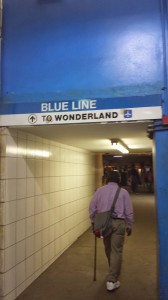

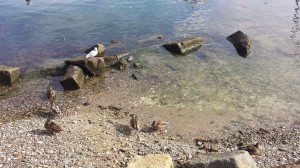



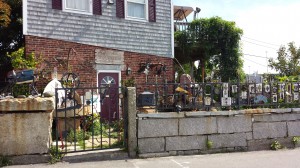
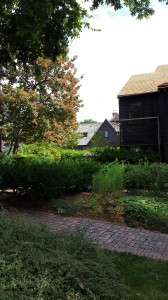

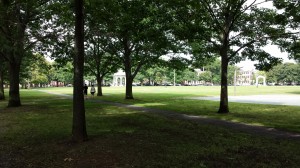
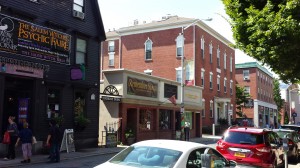
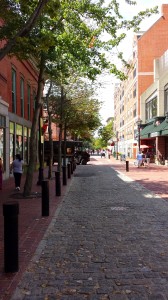
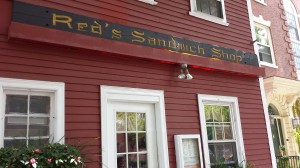
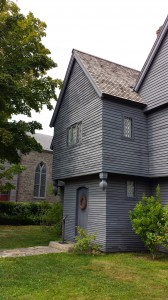
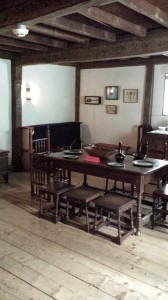
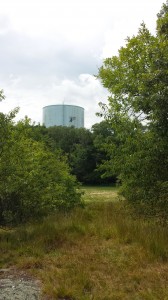
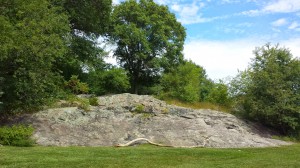
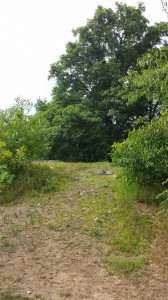
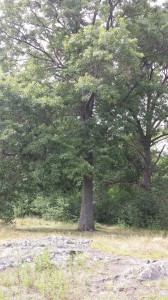
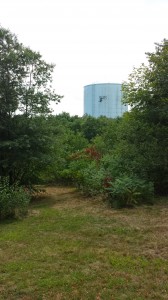
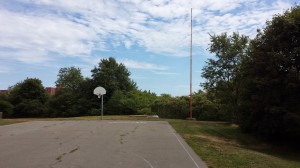
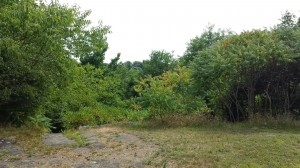
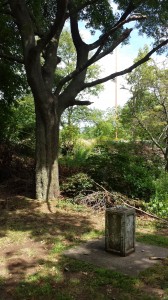
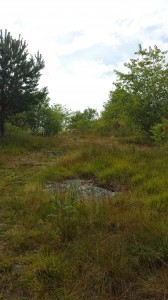
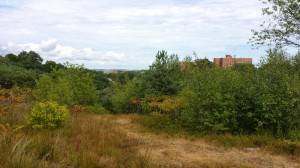
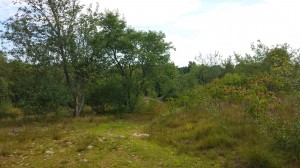


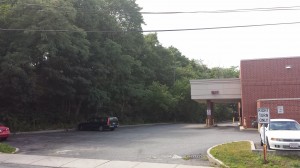
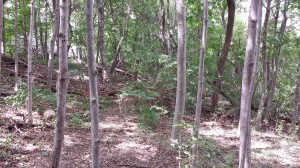
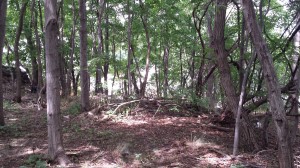
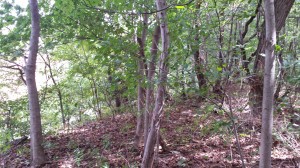


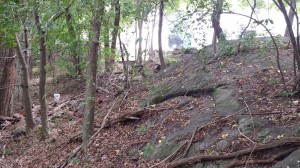
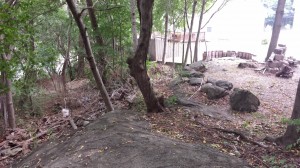
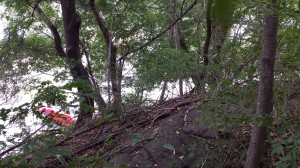


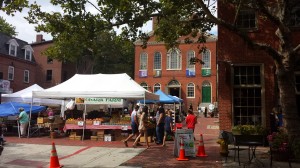

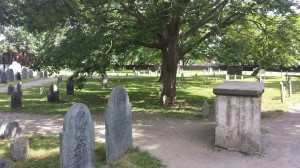
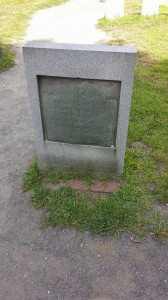
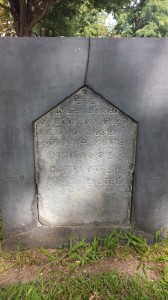
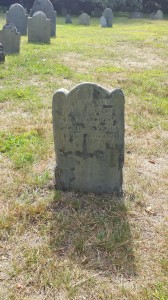
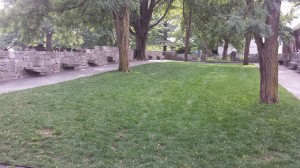
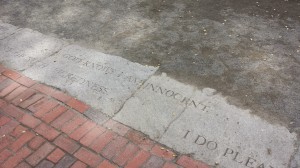
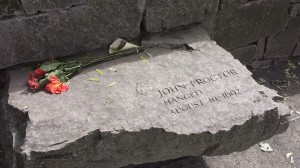
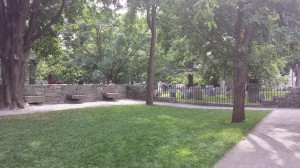
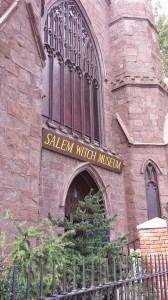
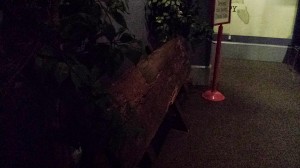

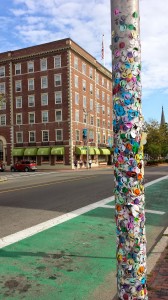


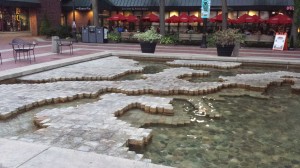
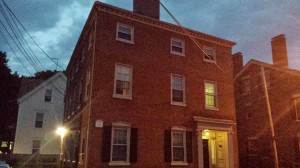
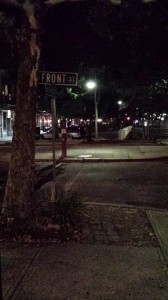
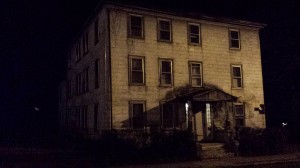

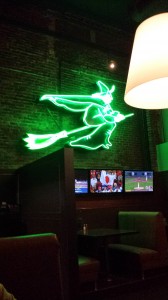

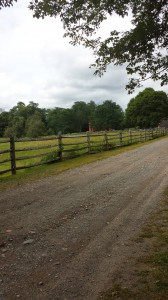
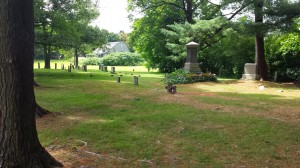

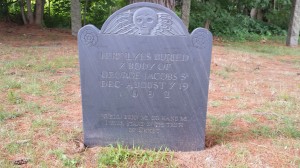
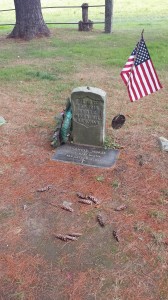
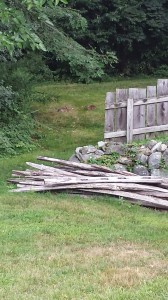
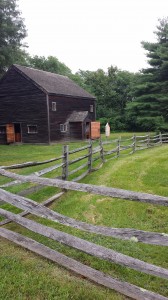
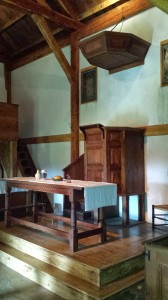
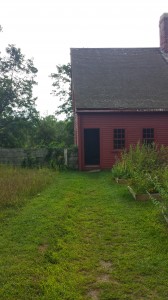
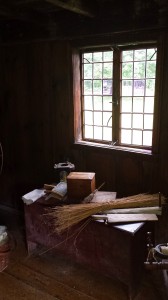
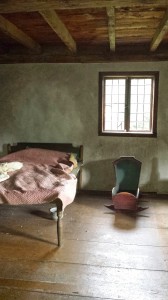
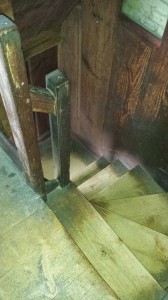
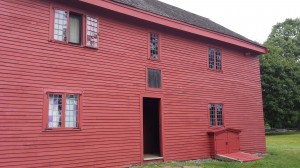
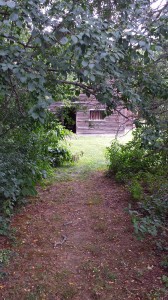
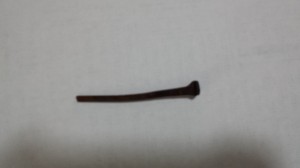
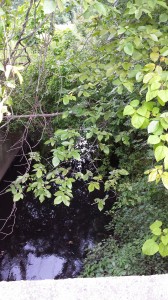
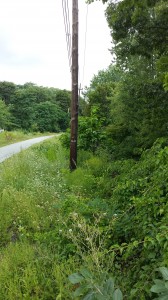

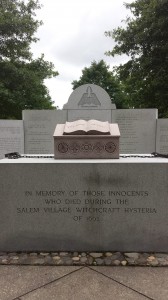
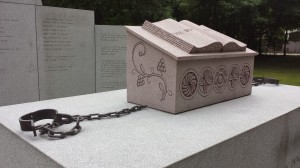

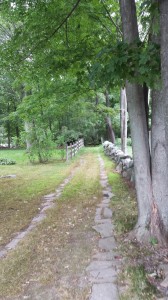
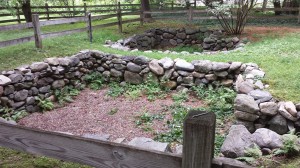
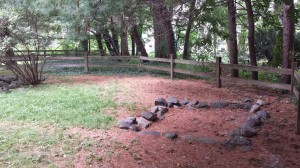
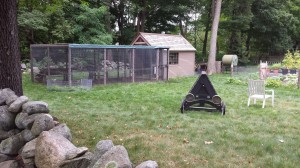
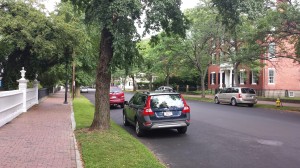
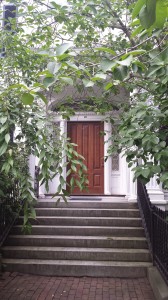
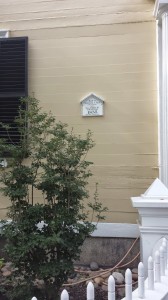
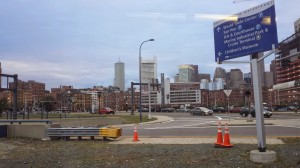
I LOVED this post. Thank you for making it! It is the next best thing to getting to go myself (which may still happen someday).
General observations:
All the odd metal things on that house are my precious.
The comments about the inaccurate hanging sites made me think of the LSAT.
The Witch House looked uber goth from the outside.
“melting” made me laugh.
Both memorials were really, really cool. I loved the sybmolism.
It’s odd that such an incogngrus current day location is where the hangings actually happened.
I still don’t like the pressing to death thing. Ugh.
The sticker pass lamp post reminded me of the Seattle gum wall.
I liked the fountain. What a pretty little place with such a morbid past!
I found it amusing that even back then, people were trying to dodge the IRS.
The house by the cemetary made me think of “Are You Afraid of the Dark”. I would have wanted to go inside.
“Sour Cream and Chive” fries Nom. Srsly. Nom.
I think Tory Row is where I wanted to go, but didn’t. Next time.
How wonderful it is that you got to go places that before you had only researched. And researched well, I might add. Who knows where that passion may take you some day in your career? Hint: I’m thinking there are books in you.
I had no idea that the Supreme Court was basically a reaction to the events in Salem.
This was very, very enjoyable. The pictures helped bring it to life, but the story was wonderfully told.
Those metal things were very nifty indeed. I think you know someone who could probably create some for you if you asked.
I hadn’t really considered the LSAT in regards to the hanging site. I guess it was deductive reasoning with a logical flow. The LSAT is also kind of like being hung.
The Witch House was interesting, I’m not really sure why it looked so dark and dreary. That color-tone and style were common, but many of the other houses managed to adhere to the style without looking like a haunted house.
I am glad you enjoyed the melting reference, I had forgot I put that in there.
I agree, the symbolism was really nifty. I wish they were more open about the symbolism, especially at Danvers. Most people are never going to have any idea what it means and thus miss the finer points of the memorial. But perhaps that was done intentionally.
As far as the location goes, history is like life, its very real, there isn’t much Hollywood here. At least it isn’t a parking lot.
Pressing to death is bad news bears. It still blows my mind they said he killed himself.
I can see the thought-pattern resemblance between the gum wall and the stickers, though the later is a bit more sanitary.
It was indeed very pretty, I think in a lot of ways that is probably something they strove for. There is a weird clash between honoring history, but not getting too deep into in Salem. Its like they want to remember certain things for certain places. I sort of allude to that in my post.
Yeah I got a good kick out of the IRS dodging windows.
I can definitely appreciate the “Are You Afraid of the Dark” overtones to that house. It was interesting, they aren’t even sure if anyone lives there. Which adds to the intrigue. When I said it was “likely” abandoned, I meant just that. Its still possible there is someone in there who just doesn’t come out.
Those fries were amazing.
It was one of the best trips I’ve had in my life and it was very low key compared to many of the trips I’ve been fortunate to have. I think I am too short-term attention span to write a book. Though its much easier to write about something when you care.
I had not idea about SCOTUS either, but it was a pretty cool factoid.
I am glad you enjoyed it. I enjoyed writing it. Its a topic I have a lot of interest because its a strong cross-section between hysteria, religion, the occult, and colonial history. Arguably its one of the best examples of such a cross section there is. I also like knowing that I figured stuff out that like maybe 10 other people on Earth know, thats kind of cool.
“The LSAT is also kind of like being hung.”
That gave me a laugh.
And you never know what you mind find to be true about yourself re: a book. You about published a slim one right here. 😉
Wow what a read! Interesting to know the real truth. You remind me of myself, Always question everything. Don’t take the natural order of things to be the sole truth, and this read is a perfect example why.Think of all the people out there that are walking around believing what isn’t so. After reading this I think you should publish your own book on the subject………………. Dad
Glad you enjoyed it! Yep, I think I have some genetic traits that encourage me to ask questions, or even if I don’t ask questions to go do the research myself. The number of people who have told me I should write a book on this topic seems to be increasing. Maybe I’ll have to consider it someday when I’m not so lazy when it comes to writing. 🙂